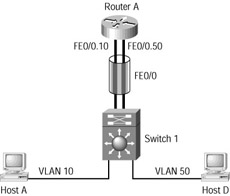Hands-On Lab
Refer to Figure 7.13 for the topology of this lab. This lab uses the simplest architecture: router on a stick using a Catalyst 6500 and an external router (7200 series).

Figure 7.13: Lab topology
-
Assume that Router A does not have MLS enabled. You can assume that the subinterfaces are running ISL and have VLAN assignments. Switch 1 is a VTP server for the Sybex domain. Configure MLS to work on Router A:
RouterA#configure terminal Enter configuration commands, one per line. End with CNTL/Z. RouterA(config)#mls rp ip RouterA(config)#interface fastethernet 4/0 RouterA(config-subif)#mls rp vtp-domain sybex RouterA(config-subif)#interface fastethernet4/0.50 RouterA(config-subif)#mls rp management-interface RouterA(config-subif)#mls rp ip RouterA(config-subif)#interface fastethernet4/0.10 RouterA(config-subif)#mls rp ip RouterA(config-subif)#^Z RouterA#
-
The aging timers need to be adjusted to be shorter than the default of 256 seconds. Make the new value 128. In addition to changing the aging timers, add a command that will help keep the layer 3 cache size under 32KB. To do this, use values of aging timer = 64 and packet threshold = 31:
Switch1> (enable) set mls agingtime 128 Multilayer switching aging time set to 128 Switch1> (enable) set mls agingtime fast 64 31 Multilayer switching fast aging time set to 64 seconds for entries with no more than 31 packets switched. Switch1> (enable)
-
Verify MLS status on the switch and router. Provide samples of the MLS entries and XTAG values.
Results will vary on this answer; here are the commands that should be issued:
-
show mls (executed on the switch)
-
show mls rp (executed on the router)
-
show mls entry (executed on the router)
-
EAN: 2147483647
Pages: 174